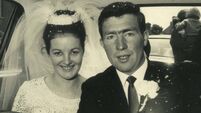Hollywood legend Lauren Bacall dies, aged 89

She was pronounced dead at New York-Presbyterian/Weill Cornell Medical Centre on Tuesday.
Bacall was a movie star from almost her first moment on the silver screen.
A fashion model and bit-part New York actress before moving to Hollywood at 19, Bacall achieved immediate fame in 1944 with one scene in her first film, To Have and Have Not.
Leaving Humphrey Bogart’s hotel room, Bacall murmured: “You don’t have to say anything, and you don’t have to do anything. Not a thing. Oh, maybe just whistle. You know how to whistle, don’t you, Steve? You just put your lips together and blow.”
Bogart, gobsmacked, seemed to fall for Bacall right on film. Their romance lasted more than 12 years until his death.
Bacall put a gold whistle in his urn with an inscription that read: “If you need anything, just blow.”
With that cool, sultry come-on, not only was a star born, but the beginning of a legend.
Bacall followed up the debuts with a remarkable string of films. Few actors have ever emerged so resoundingly: the labyrinthine William Faulkner co-scripted private eye tale, The Big Sleep, the perspective-shifting Dark Passage, and the stormy Florida noir Key Largo by John Huston.
She starred in all with Bogart, forging an uncommonly strong partnership both professionally and personally. Their romance carried along on the screen; in The Big Sleep, they again jousted with bristling dialogue. In one famous scene, they flirted with horse-racing double-entendres:
Bogart: “You’ve got a touch of class but I don’t know how far you can go.”
Bacall: “A lot depends on who’s in the saddle.”
Bacall would outlive her husband by more than 50 years, but never outlive their iconic status. They were “Bogie and Bacall” — the hard-boiled couple who could fight and make up with the best of them. Unlike Spencer Tracy and Katharine Hepburn, Bogart and Bacall were not a story of opposites attracting but of kindred, smouldering spirits.
They threw all-night parties, palled around with Frank Sinatra and others and formed a gang of California carousers known as the Holmby Hills Rat Pack, which Sinatra would resurrect after Bogart’s death.
The Academy-Award nominated actress received two Tonys, an honorary Oscar and scores of film and TV roles. But, to her occasional frustration, she was remembered for her years with Bogart and treated more as a star by the film industry than as an actress.
Not until 1996 did she get an Oscar nomination — as supporting actress for her role as Barbra Streisand’s mother in The Mirror Has Two Faces. She was beaten by Juliette Binoche for her performance in The English Patient.
She finally got a statuette in November 2009 at the movie academy’s Governors Awards gala. “The thought when I get home that I’m going to have a two-legged man in my room is so exciting,” she quipped.
Her persona paralleled her screen appearances: She was blunt, with a noirish undertone of sardonic humour that illuminated her 1979 autobiography By Myself (she published an updated version in 2005, By Myself and Then Some).
Bacall was born Betty Joan Perske in the Bronx on September 16, 1924, and was raised by her Romanian mother after her parents split when she was a child. Her mother took part of her family name, Bacal; Betty added the extra L.
As a young woman, Diana Vreeland, the famed editor of Harper’s Bazaar, thought she was ideal for fashion modelling and Bacall appeared regularly in the magazine. The wife of film director Howard Hawks saw her on a magazine cover and recommended her as film material and she went to Hollywood.
Hawks became her mentor, coaching her on film acting and introducing her to Hollywood society. He was preparing a movie to star Bogart, based on an Ernest Hemingway story, To Have and Have Not.
By this time she had acquired the professional name of Lauren, though Bogart and all her friends continued to call her Betty.
She wrote of meeting Bogart: “There was no thunderbolt, no clap of thunder, just a simple how-do-you-do.”
Work led to romance. The 23-year age difference (he called her Baby) failed to deter them, but they faced a serious obstacle — Bogart was still married to the mercurial actress Mayo Methot. She was persuaded to divorce him, and the lovers were married on May 21, 1945.
“When I married Bogie,” she remarked in 1994, “I agreed to put my career second because he wouldn’t marry me otherwise. He’d had three failed marriages to actresses and he was not about to have another.”
But in March 1956, Bogart was diagnosed with cancer of the oesophagus. On January 14, 1957, he grabbed his wife’s arm and muttered: “Goodbye, kid.” He died aged 57.
After a period of mourning, Bacall became romantically involved with Sinatra, but when an “engagement” was mistakenly leaked, the singer blamed her and terminated the romance.
Bacall left Hollywood in October 1958. She made a film in England and did a critically panned play where she would meet her second husband, Jason Robards.
He was also an accomplished actor, hard drinker — and married. After Robards was divorced from his second wife, he and Bacall married in 1961 but Robards’ drinking and extramarital affairs resulted in divorce in 1969.
Applause in 1970 and Woman of the Year in 1981 brought Bacall Tony awards. Her later movies included Murder On the Orient Express, The Shootist and Robert Altman’s Ready To Wear. She played Nicole Kidman’s mother in 2004’s Birth and in recent years appeared as herself in a cameo for The Sopranos.
Bacall became friends with William Faulkner when he was writing scripts for Hawks. One of her prized possessions was a copy of Faulkner’s Nobel Prize acceptance speech on which he wrote that she was not one who was satisfied with being just a pretty face, “but rather who decided to prevail”.
“Notice he didn’t write ‘survive’,” she told Parade magazine in 1997. “Everyone’s a survivor. Everyone wants to stay alive. What’s the alternative? See, I prefer to prevail.”
But it was those early black-and-whites where Bacall — nicknamed “The Look” — most thrived.
She was in many ways our last tether to a bygone era of Hollywood where movies were sumptuously shaded and the dialogue crackled. In both, Bacall — a match that burned brightest when first struck — had few peers.













